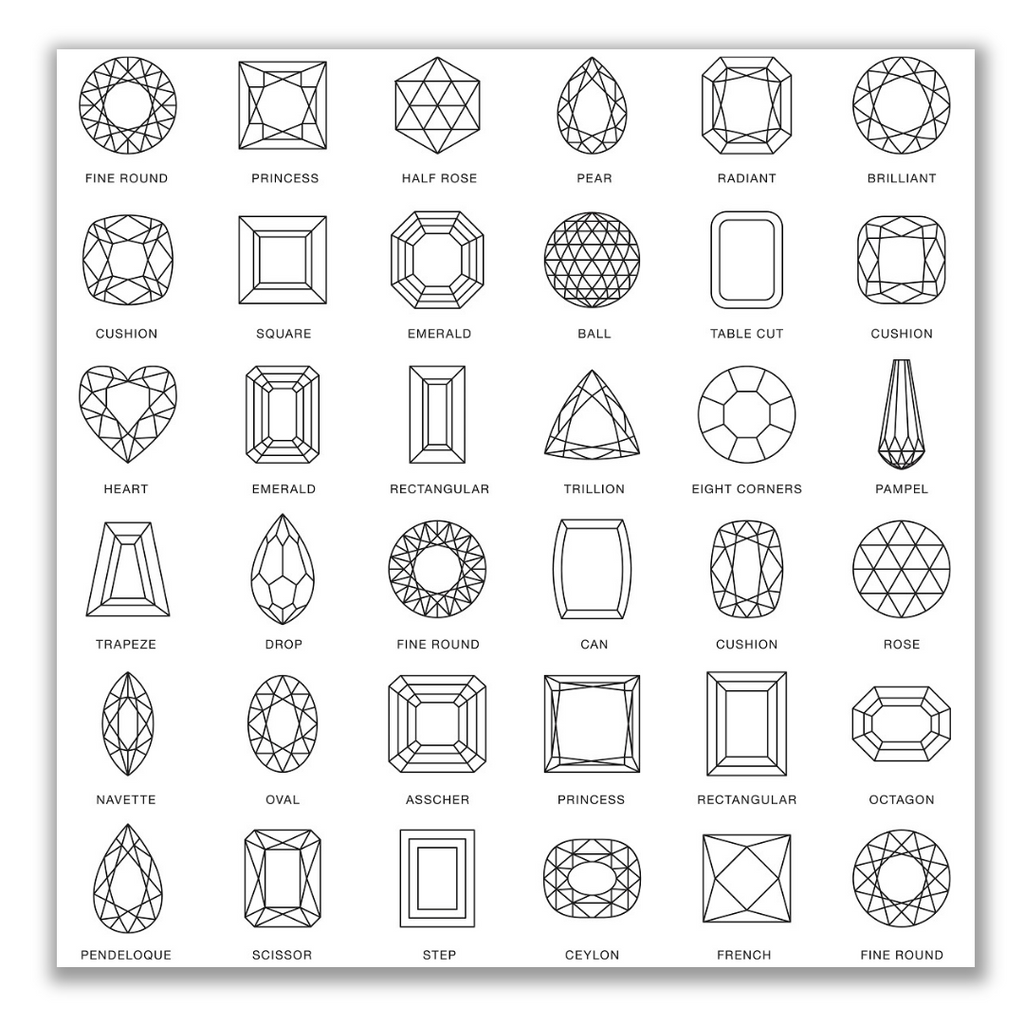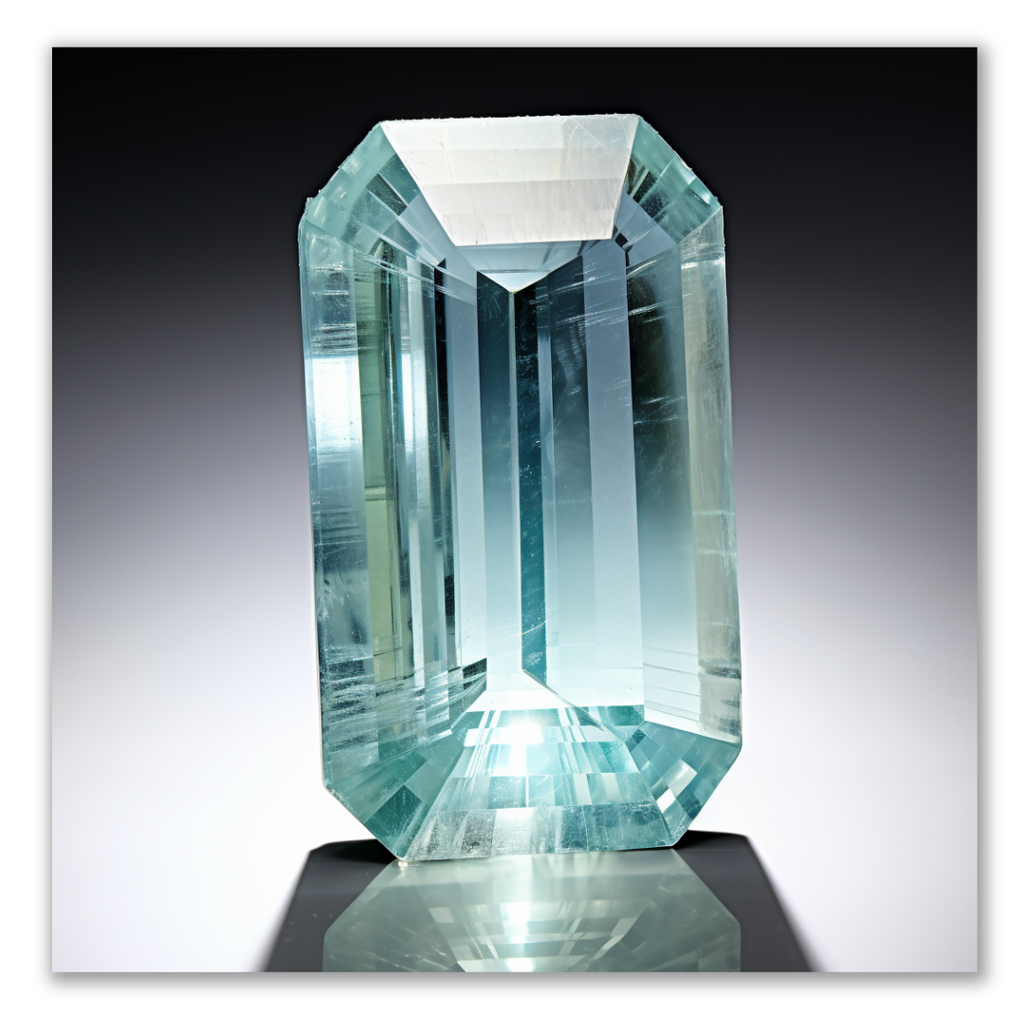Importance of Gemstone Cuts and Shapes

Gemstone cuts and shapes play a crucial role in the overall beauty, brilliance, and value of a gemstone. The way a gemstone is cut and shaped directly influences its appearance, light performance, and visual appeal. Here are some key reasons why gemstone cuts and shapes are essential.

Brilliance and Sparkle:
Brilliance and sparkle are essential characteristics that determine the beauty and visual appeal of a gemstone, particularly in diamonds and other transparent gemstones. They refer to the gem's ability to reflect and refract light, creating a stunning display of flashes, colors, and scintillation. Let's explore these two aspects in more detail:
- Brilliance: Brilliance refers to the intense brightness and white light that a gemstone emits when light enters and reflects off its surface and internal facets. It is a result of the gem's ability to refract light and reflect it back to the observer. A well-cut gemstone will have precise and symmetrical facets that effectively bounce light within the stone, enhancing its brilliance.
The cut of the gemstone plays a significant role in its brilliance. Diamonds, for instance, are known for their exceptional brilliance due to their brilliant-cut faceting pattern, which maximizes light return. Other gemstones like sapphires, rubies, and emeralds can also exhibit brilliant sparkle if they are cut with precision and in a shape that optimizes light reflection.
- Sparkle (Scintillation): Sparkle, also known as scintillation, refers to the flashes of light that a gemstone displays as it moves or is viewed from different angles. It is a result of light interacting with the gemstone's facets and producing contrasting areas of brightness and darkness. Scintillation adds life and movement to the gem, making it mesmerizing and captivating to the eye.

Diamond Sparkles
The interaction between the observer, the gemstone, and the light source determines the scintillation effect. When you move the gem or change the viewing angle, the facets interact with the light differently, creating a sparkling effect. Gemstones with well-cut and symmetrical facets will display more pronounced and captivating scintillation.
Achieving Optimal Brilliance and Sparkle:
To achieve optimal brilliance and sparkle in a gemstone, several factors come into play:
-
Cut Quality: The most critical factor is the cut quality of the gemstone. A well-cut gemstone with precise and symmetrical facets will maximize light return and display exceptional brilliance and sparkle.
-
Transparency and Clarity: A gemstone with high transparency and minimal inclusions or flaws will allow light to pass through without obstruction, enhancing its brilliance.
-
Light Source: The type and intensity of the light source can affect how the gemstone reflects light. Ideally, natural daylight or white light will showcase the gem's brilliance and sparkle best.
-
Viewing Angle: Changing the viewing angle or moving the gemstone will produce different scintillation effects, adding to its dynamic and dazzling appearance.

Transparency and Clarity:

Transparency and clarity are two important characteristics used to evaluate the quality and value of gemstones, particularly in diamonds and other transparent gemstones. While these terms are related, they refer to different aspects of a gemstone's appearance and overall visual quality.
- Transparency: Transparency refers to how well light passes through a gemstone without obstruction or distortion. Transparent gemstones allow light to pass through freely, making them appear clear and brilliant. When light passes through a transparent gemstone, it should not scatter or absorb significant amounts of light.
The transparency of a gemstone is influenced by its internal structure and the presence of any inclusions or imperfections. Gemstones with a high level of transparency are highly prized, as they allow light to interact with the stone, maximizing its brilliance and sparkle.

Different levels of transparency in gemstones include:
- Transparent: Light passes through the gemstone with no scattering or distortion, resulting in excellent brilliance and clarity.
- Translucent: Light passes through the gemstone but with some scattering or haziness, reducing brilliance.
- Opaque: No light passes through the gemstone, making it appear solid and non-transparent.

- Clarity: Clarity refers to the presence or absence of internal and external flaws, known as inclusions and blemishes, in a gemstone. Inclusions are natural imperfections within the gemstone, such as tiny crystals, mineral traces, or other materials that were trapped during the gem's formation. Blemishes, on the other hand, are surface imperfections, such as scratches or chips.

The Gemological Institute of America (GIA) grades diamond clarity on a scale that includes the following grades:

- Flawless (FL) / Internally Flawless (IF): No inclusions or blemishes visible under 10x magnification.
- Very, Very Slightly Included (VVS1/VVS2): Inclusions extremely difficult to see under 10x magnification.
- Very Slightly Included (VS1/VS2): Inclusions visible under 10x magnification but not easily noticeable to the naked eye.
- Slightly Included (SI1/SI2): Inclusions visible under 10x magnification and may be slightly visible to the naked eye.
- Included (I1/I2/I3): Inclusions visible to the naked eye, affecting the gemstone's transparency and brilliance.
In colored gemstones, a similar grading system is used to assess clarity, although the criteria may vary depending on the gemstone type.

Customization:

Customization in the context of gemstones refers to the ability to create personalized and unique pieces of jewelry or decorative items tailored to an individual's specific preferences and requirements. It allows customers to be actively involved in the design process, ensuring that the final product aligns with their vision and style.
Customization can be applied to various aspects of gemstone jewelry, including:
-
Gemstone Selection: With customization, customers can choose their preferred gemstones, such as diamonds, sapphires, emeralds, rubies, or other precious and semi-precious gemstones. They can select the color, size, shape, and quality of the gemstone to suit their taste and budget.
-
Jewelry Design: Customization offers the opportunity to create one-of-a-kind jewelry designs that reflect the wearer's personality and style. Customers can work with jewelry designers or artisans to sketch or describe their vision, incorporating specific elements and motifs into the design.
-
Metal Type: Customers can choose the metal type for their jewelry, such as gold (white, yellow, or rose), platinum, silver, or other precious metals. The metal choice can significantly impact the overall aesthetics and durability of the piece.
-
Setting Styles: The setting style of the gemstone can be customized, allowing customers to choose from various settings, including prong, bezel, pave, channel, or halo settings, to highlight and protect the gemstone.
-
Engravings and Inscriptions: Customization may include adding meaningful engravings or inscriptions to the jewelry, such as initials, names, dates, or heartfelt messages, adding sentimental value to the piece.
-
Sizing: Custom-made jewelry ensures that it fits perfectly, as the sizing is tailored to the individual's measurements. This avoids the need for resizing or adjustments later on.
-
Personalized Gifts: Customized gemstone jewelry makes for thoughtful and memorable gifts for special occasions like engagements, weddings, anniversaries, or birthdays. The personal touch adds sentiment and significance to the gift.
Benefits of Customization:
-
Uniqueness: Customized gemstone jewelry is unique and not mass-produced, making it one of a kind. This exclusivity adds to its value and sentimental meaning.
-
Personal Expression: Customization allows individuals to express their creativity and personal style, resulting in jewelry that truly represents their tastes and preferences.
-
Quality Assurance: By being actively involved in the design process, customers can ensure that the gemstones and materials used meet their desired standards of quality.
-
Emotional Value: Custom-made jewelry often carries emotional significance, as it is designed to mark special moments and memories in the wearer's life.
-
Flexibility: Customers have the flexibility to adjust design elements, gemstone choices, and budget to suit their needs and preferences.

Durability and Wearability:

Elizabeth Taylor
Durability and wearability are essential considerations when choosing gemstones for jewelry. These characteristics determine how well a gemstone can withstand everyday wear, resist damage, and maintain its beauty over time. Here's a closer look at each aspect:
- Durability: Gemstone durability refers to its ability to withstand wear, scratches, and other potential damage without significant loss of quality or structural integrity. Some gemstones are harder and more resistant to abrasion, making them suitable for daily wear, while others are softer and require more careful handling.
The Mohs scale of mineral hardness is commonly used to measure a gemstone's resistance to scratching. It ranges from 1 (softest) to 10 (hardest):
-
Soft Gemstones (1-3): Gemstones with a hardness of 1 to 3, such as talc, gypsum, and fluorite, are considered soft and not ideal for everyday wear in jewelry due to their vulnerability to scratching and chipping.
-
Medium-Hard Gemstones (4-6): Gemstones with a hardness of 4 to 6, such as emerald, pearl, and tanzanite, are relatively durable but may require more care to prevent damage.
-
Hard Gemstones (7-10): Gemstones with a hardness of 7 to 10, including sapphire, ruby, and diamond, are considered hard and durable, making them suitable for everyday wear in various types of jewelry.
- Wearability: Wearability refers to how comfortable and practical a gemstone is for everyday use in jewelry. Some factors that affect wearability include:
-
Cut and Setting: The cut and setting of the gemstone can impact how it sits on the jewelry and interacts with the wearer's skin. Smooth, rounded edges and well-crafted settings enhance comfort.
-
Prong and Bezel Settings: Certain settings, like prong settings, expose more of the gemstone's surface, making them more vulnerable to wear and damage. Bezel settings, on the other hand, provide better protection.
-
Activities and Lifestyle: The wearer's lifestyle and activities should be considered when choosing gemstones for jewelry. For those with active lifestyles, more durable and less delicate gemstones are recommended.
-
Special Occasions vs. Everyday Wear: Some gemstones may be more suitable for special occasion jewelry, where they receive less exposure to potential hazards.
Balancing Durability and Wearability:
To strike a balance between durability and wearability, consider the following:
-
Gemstone Hardness: Choose gemstones with a higher hardness (7 and above on the Mohs scale) for pieces intended for everyday wear.
-
Protective Settings: Opt for settings that offer good protection to the gemstone, such as bezel or half-bezel settings.
-
Maintenance: Regular cleaning and maintenance can help preserve the beauty and condition of gemstone jewelry.
-
Occasional Wear: For softer or more delicate gemstones, consider reserving them for special occasions to minimize wear and tear.

Market Value:

Market value in the context of gemstones refers to the current worth or price of a particular gemstone in the market. It is determined by various factors, including the gemstone's rarity, quality, demand, size, color, and overall desirability. Understanding market value is essential for buyers, sellers, and investors in the gemstone industry.
Factors Influencing Market Value of Gemstones:
-
Rarity: Gemstones that are rare and difficult to find are generally more valuable in the market. For example, certain colored diamonds, such as pink and blue diamonds, are exceptionally rare and command high prices.
-
Quality: Gemstone quality is a critical factor affecting market value. High-quality gemstones exhibit excellent color, clarity, and cut, maximizing their beauty and desirability. Well-cut and eye-clean gemstones are often more valuable than those with visible flaws and inclusions.
-
Demand: The level of demand for a particular gemstone significantly impacts its market value. Gemstones that are popular and in high demand among consumers tend to have higher prices.
-
Color: The color of a gemstone can greatly influence its value. Vivid, intense, and rare colors are highly sought-after and more valuable than pale or common shades.
-
Size: In general, larger gemstones are more valuable than smaller ones of the same type and quality. Larger gemstones are rarer, as fewer of them are found in nature.
-
Origin: Gemstones with specific origins or famous mining locations can have added value. For example, a gemstone sourced from a renowned mine may command a premium due to its historical significance.
-
Certification: Independent gemological certification from reputable laboratories, such as GIA (Gemological Institute of America), can provide assurance of a gemstone's quality and authenticity, influencing its market value.
-
Trends and Fashion: Market value can be influenced by current trends and fashion preferences. A gemstone that becomes fashionable or is featured prominently in the media may experience a surge in demand and value.
-
Economic Conditions: Economic factors, including inflation, currency fluctuations, and overall market conditions, can also impact the market value of gemstones.
It is important to note that gemstone market values can fluctuate over time based on supply and demand dynamics, economic conditions, and other factors. Therefore, regular market research and staying updated with industry trends are essential for making informed decisions when buying or selling gemstones.










